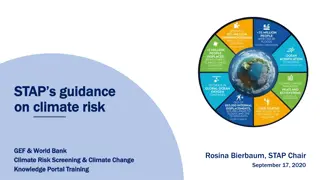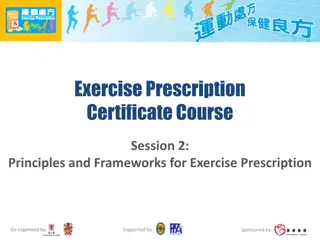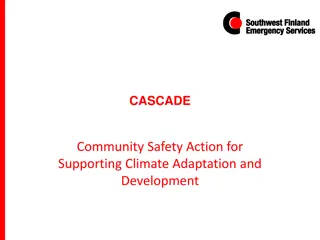Climate Change Risk Assessment Exercise for Business Operations
This exercise aims to identify, assess, and rank the negative effects of climate change on a company's business operations. It involves analyzing past and projected climate phenomena, assessing their probability and magnitude, and deriving risk values to create a risk matrix. The exercise covers steps like identifying negative effects, assessing their likelihood, and developing a comprehensive understanding of risks posed by climate change.
Download Presentation

Please find below an Image/Link to download the presentation.
The content on the website is provided AS IS for your information and personal use only. It may not be sold, licensed, or shared on other websites without obtaining consent from the author.If you encounter any issues during the download, it is possible that the publisher has removed the file from their server.
You are allowed to download the files provided on this website for personal or commercial use, subject to the condition that they are used lawfully. All files are the property of their respective owners.
The content on the website is provided AS IS for your information and personal use only. It may not be sold, licensed, or shared on other websites without obtaining consent from the author.
E N D
Presentation Transcript
Exercise Module 2a Assessing Climate Change Risks Country, Date, Presenter Page 1
Objective The objective of this exercise is to: Identify and describe the negative effects of climate change for the case company and locations where the supply chain may be concerned Rate the anticipated probability and magnitude pertaining to the different negative effects for the company Derive risk values that enable ranking the spectrum of risks for the company in a matrix Page 2 ToC - Module 2a Exercise
Step 1 Step 2 Step 3 Step 4 Identify neg. effects on the business Assess probability Assess magnitude Derive risk value and develop risk matrix Page 4 ToC - Module 2a Exercise
Step 1 Step 2 Step 3 Step 4 Identify neg. effects on the business Assess probability Assess magnitude Derive risk value and develop risk matrix Page 5 ToC - Module 2a Exercise
Introduction to STEP 1 Identify neg. effects on the business In STEP 1 of this exercise you will identify and describe the neg. effects on the business resulting from the impacts of the relevant climate phenomena. Please state the negative effect together with the impact: Destruction of machinery due to flooding Reduction of worker productivity due to heat wave Consider the results of the previous module; make sure that you also include potential future negative effects on the business that the company has not yet experienced Describe the negative effects by detailing the location, the affected goods or services, or the impact area; moreover, define a timeframe for each effect Page 6 ToC - Module 2a Exercise
Step 1 Step 2 Step 3 Step 4 Identify neg. effects on the business Assess probability Assess magnitude Derive risk value and develop risk matrix Page 7 ToC - Module 2a Exercise
Introduction to STEP 2 Assess the probability of negative effects on the business Past climate change phenomenon Projected climate change phenomenon STEP 2 of this exercise is about analyzing the probability of the risks to materialize for the company. To determine the probability, see how often the climate phenomena and resulting impacts have occurred historically. On this basis, estimate when and how often they might reoccur; keep in mind the validity of data. Impact Probability of negative effects on the business Build your own probability scale and apply it consistently; values will only be indicative Page 8 ToC - Module 2a Exercise
Introduction to STEP 2 Assess the probability of negative effects on the business Probability of 1 a) The occurrence of the negative effect on the business is not very likely b) It has not occurred in the past and is not expected to occur in the next 1-2 years c) Once the related climate phenomenon occurs, the negative effect on the business does not follow directly Deduct probability from statements of the following type: Probability of 3 a) The occurrence of the negative effect on the business is deemed possible b) It has occurred in the past and /or it is expected to occur but not in the next 1-2 years c) Once the related climate phenomenon occurs, the negative effect on the business follows with only little delay For example, flooding that damaged company machinery and led to interruption occurred on average once every 5 years over the course of the past 50 years. Yet in the past 10 years there have been 3 floods of this type. Probability of 5 a) The occurrence of the negative effect on the business is deemed very likely b) It has occurred in the past and/or it is expected to occur in the next 1-2 years c) Once the related climate phenomenon occurs, the negative effect on the business follows directly and immediately after Scientist project that the frequency of heavy rain events that cause the floods will increase by 30 % over the next 20 years. Page 9 ToC - Module 2a Exercise
Step 1 Step 2 Step 3 Step 4 Identify neg. effects on the business Assess probability Assess magnitude Derive risk value and develop risk matrix Page 10 ToC - Module 2a Exercise
Introduction to STEP 3 Assess magnitude of negative effects on the business Magnitude of 1: Magnitude of 1: a) Negative effect on the business occurs but its effect on the bottom line is limited b) Production processes and/or value chain are not interrupted c) Stakeholder relations are not affected STEP 3 of this exercise is about assessing the negative effects that the company may has to incur on its business. Magnitude of 3: a) Negative effect on the business occurs and has a significant effect on the bottom line, endangering its growth potential b) Production processes or value chain are interrupted c) Stakeholder relations are affected and necessitate countermeasures Although the damage is not specified in monetary terms in this step, defining the magnitude should be informed by economic considerations. Magnitude of 5: a) Negative effect on the business occurs and endangers the survival of the company b) Production processes and value chain are interrupted c) Stakeholder relations are endangered and the license to operate is in question It should be taken into account what impact the damage of a particular risk has on the case bottom line. The highest magnitude score should only be given if a risk has the potential to threaten the survival of the business Page 11 ToC - Module 2a Exercise
Step 1 Step 2 Step 3 Step 4 Identify neg. effects on the business Assess probability Assess magnitude Derive risk value and develop risk matrix Page 12 ToC - Module 2a Exercise
Introduction to STEP 4 Derive risk value and develop risk matrix STEP 4 of this exercise is about deriving the risk value for each risk and inserting it into a risk matrix to allow for a prioritization of the risks the company faces. Risks can be quantified, and hence prioritized Derive the risk value by multiplying the probability of the negative effects on the business with its expected magnitude Subsequently, insert the resulting risk values into the risk matrix. Page 13 ToC - Module 2a Exercise
Guidance for Participants Derive risk value and develop risk matrix For this task you should Join your consultant group Define the risk, assess probability and magnitude and damage, derive the risk value an then insert it in the risk matrix Write the risk values for each risk on the corresponding risk card; also fill them in the Excel Put the risk cards on the risk matrix meta plan You have 60 min for this task Page 14 ToC - Module 2a Exercise
Guidance for Participants Derive risk value and develop risk matrix Impacts of Climate Change Phenomenon Identified negative effects Spoilage of fruits due to flooding / P: 2 / M: 2 / Risk value: 4 More frequent and stronger flooding Destruction of buildings due to landslides / P: 4 / M: 3 Risk value: 12 Landslides Absenteeism of workers due to vectorborne diseases / P: 1 / M: 4 Risk value: 4 Vector-borne diseases Page 15 ToC - Module 2a Exercise
Discussion Comparing results This exercise is about presenting the results to your peers and discussing how this is relevant for any real climate change adaptation assessment. After presenting the results discuss the following questions: Do you think that this methodology is sufficiently precise to identify the central risks of a company? What could be challenges in applying this step to a real company? Page 16 ToC - Module 2a Exercise
Thank you for your attention! Company Company Trainer 1 Telephone number E-Mail address Trainer 2 Telephone number E-Mail address Homepage Homepage Knowledge partner Page 17 ToC - Module 2a Exercise























